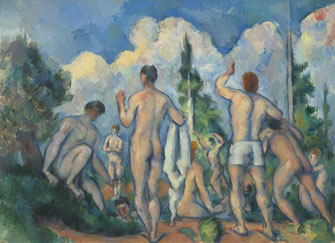Off with the Fig Leaf:
Baring the Male Body

Paul Cézanne’s “Baigneurs” (c. 1890). © RMN (Musée d’Orsay)/Hervé Lewandowski
After you leave the exhibition “Masculine/
Masculine: The Male Nude in Art from 1800 to the Present,” don’t be surprised if you find yourself undressing every man you see with your eyes. It’s a normal side effect of this huge show of paintings, sculptures and photographs of naked men at the Musée d’Orsay.
The show, which debuted in a somewhat different form at the Leopold Museum in Vienna last year, is probably the first such wide-ranging exhibition on the subject ever, even though the male nude has been a common subject throughout the history of art, and it is indeed refreshing to see the male rather than the female body in the spotlight for a change.
Full-frontal nudity was not always accepted, however; the catalogue tells the wonderful story of how Queen Victoria got the vapors when she visited the Victoria & Albert Museum and saw the private parts on the replica of Michelangelo’s “David.” Thereafter, a clip-on fig leaf was trotted out to hide the offending bits whenever a royal visitor was announced.
Plenty of fig leafs appear in the works at the Orsay – as well as ribbons and scraps of cloth that just happen to fall over the naughty parts – but many more let it all hang out.
The show is organized thematically rather than chronologically, mixing up eras and sensibilities in an interesting way, beginning with the classical ideal and continuing with the heroic nude; gods of the stadium, the trials and tribulations of heroes, 19th-century Realism and the Expressionist reaction to it; raw, uncompromising depictions of the body alive and dead, among them Ron Meuck’s undersized, lifelike (or, in this case, deathlike) sculpture of his father’s corpse; the nude in nature; the body in pain; and the body glorified.
The show ends with two sections on erotic depictions of the male body – “The Temptation of the Male” and “The Object of Desire,” both of which have a predominantly homoerotic slant and pretty much ignore the male-female erotic relationship, with a few exceptions. One strange painting by Ferdinand Hodler, “Spring III” (1907-10), shows a naked boy sitting on the ground staring straight ahead at the viewer and completely ignoring the girl in a white robe kneeling on the ground facing him, who seems to be in a paroxysm of ecstasy.
The exhibition contains a disproportionately large number of works by French artists Pierre et Gilles, famed for their beautifully kitschy staged color photos paying homage to a theme, period or person. The best here are “Mercury” (2001), a perfect pastiche of the mythological personage, and their amusing “Vive la France” (2006), showing three soccer players – one black, one North African and one white – wearing only socks in the colors of the French flag.
As far as subject matter goes, Saint Sebastian is, of course, a popular theme, with depictions ranging from Guido Reni’s beautiful and virile representation of the writhing martyr to the extremely effeminate one in George de la Tour’s “Saint Sebastian Tended by Saint Irene” (undated) and Alfred Courmes’ homoerotic “Saint Sebastian Seen from Behind at the Saint-Martin Lock” (1974) in which he is portrayed as a bare-bottomed sailor.
One of the appealing aspects of this exhibition is that it includes familiar favorites like Rodin’s studies of an old, overweight naked Balzac as well as many works by lesser-known artists like Karl Sterrer, whose muscle-bound “Titan, or Atlas” (1910) strains to hold up the world, and George Desvallières, whose large-scale pastel, “Archers” (1895) has a complex composition in shades of brown filled with the interlaced bodies of naked archers. The blue arcs of their bows slash through the picture, while the birds they are hunting flap around their heads. Another example is “Spring” (1900) by Kolomon Moser, featuring a wonderful leaping nude in a mountain pasture, painted in Cézannian greens, blues and earth tones and hung not far from one of Cézanne’s own “Bathers” (c. 1890).
While the exhibition is almost overwhelmingly long, it is apparently impossible to overdose on male nudes, and, for better or worse, the side effect I mentioned at the beginning of this article seems to be temporary.
Musée d’Orsay: 1, rue de la Légion d’Honneur, 75007 Paris. Métro: Solferino. RER: Musée d’Orsay. Tel.: 01 40 49 48 14. Open Tuesday-Sunday, 9:30 a.m.-6 p.m., until 9:45 p.m. on Thursday. Closed Christmas Day and New Year’s Day. Admission: €12. Through January 2, 2014. www.musee-orsay.fr
Click here to read all of this week’s new articles on the Paris Update home page.
Reader reaction: Click here to respond to this article (your response may be published on this page and is subject to editing).
Please support Paris Update by ordering books from Paris Update’s Amazon store at no extra cost. Click on your preferred Amazon location: U.K., France, U.S.
To order the catalog from this exhibition: click here: U.K., France, U.S.
More reviews of Paris art shows.
© 2013 Paris Update
Favorite